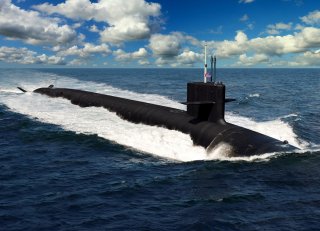Columbia: The U.S. Navy's New Missiles Submarines Can Kill Countries
On October 1, 2020, construction began on the future USS Columbia (SSBN-826), the first of a new class of U.S. Navy nuclear-powered submarines to replace the Ohio-class ballistic missile submarines now in service. The program calls for twelve of the new class of boats, which the Navy has identified as a top priority.
On October 1, 2020, construction began on the future USS Columbia (SSBN-826), the first of a new class of U.S. Navy nuclear-powered submarines to replace the Ohio-class ballistic missile submarines now in service. The program calls for twelve of the new class of boats, which the Navy has identified as a top priority.
History
Research and development work on the new class of SSBNs has been underway for several years, while advanced procurement (AP) funding for the lead vessel began in fiscal year 2017 (FY17). According to the December 22, 2020 updated Congressional Research Service (CRS) report, "Navy Columbia (SSBN-826) Class Ballistic Missile Submarine Program: Background and Issues for Congress," the Navy’s proposed FY2021 budget requests
$2,891.5 million (i.e., about $2.9 billion) in procurement funding, $1,123.2 million (i.e., about $1.1 billion) in advance procurement (AP) funding, and $397.3 million in research and development funding for the program. In addition to the future SSBN-826, the Navy has announced that it would procure the second Columbia-class boat – the future USS Wisconsin (SSBN-827) – in FY24.
General Dynamics Electric Boat will perform about seventy-eight percent of the construction, and it reportedly shifted the program to full-scale construction at the company's manufacturing complex in Quonset Point, Rhode Island – where construction of four of the six "supermodules" will take place. Following the completion of the modules, all will be transported by barge to Electric Boat's Final Test and Assembly facility in Groton, Connecticut.
Critical Component of the Nuclear Triad
The SSBNs are seen as a critical component of the U.S. military, as the SSBNs now carry seventy percent of the U.S. operational nuclear deterrent arsenal and are considered the most survivable leg of the nation's nuclear triad. At issue is that the current Ohio-class SSBNs will begin to reach their end of service life in 2027 – and as a result between 2032 and 2040, the Navy will only have the minimum SSBN force structure deemed necessary to meet the United States Strategic Command (USSTRATCOM) strategic deterrent requirements.
According to the Submarine Industrial Base Council, the third-party organization representing the more than 4,000 companies across all 50 states, "Delivery of the Columbia Class on schedule maintains the minimum force structure necessary to meet USSTRATCOM’s requirements. The existing Ohio Class SSBNs' service lives have been extended from an initial 30 years to an unprecedented 42 years. There is no margin to further extend the service life of the current SSBNs which will begin to reach their end of service life in 2027.
The new Columbia-class will be the largest submarines ever built by the United States. The subs are 560 feet in length with a beam of 43 feet. The class is being constructed with a life-of-ship reactor, which will result in a shorter mid-life maintenance period. Each of the boats is designed to serve a forty-two-year service life.
According to the recent CRS report, the Columbia-class will include a total of 16 SLBM tubes, as opposed to 24 SLBM tubes (of which 20 are now used for SLBMs) on Ohio-class SSBNs.
Peter Suciu is a Michigan-based writer who has contributed to more than four dozen magazines, newspapers and websites. He regularly writes about military small arms, and is the author of several books on military headgear including A Gallery of Military Headdress, which is available on Amazon.com.

